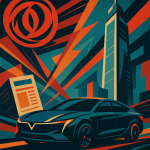- Sharp market reaction: 亿纬锂能 (EVE Energy) saw a 12.08% jump the day after its Chengdu announcement and rose over 35% in five trading days to ~¥1,595.66 billion market value; equipment supplier 先导智能 climbed roughly 51.51% in five trading days, reaching ~¥842.60 billion.
- Prototype performance & near‑term capacity: EVE’s “Longquan No.2” is a 10 Ah full‑solid cell at 300 Wh/kg and 700 Wh/L; its Chengdu base targets ~500,000 cells/year, with Phase II aiming for 100 MWh by Dec 2026 and a roadmap to ~350 Wh/kg & 800 Wh/L by 2026.
- “Shovel sellers” are early winners: Equipment vendors supplying full‑line solid‑state production see outsized demand — 先导智能 reported H1 2025 revenue ¥6.61 billion, net profit ¥740 million, and operating cash flow ¥2.353 billion, highlighting monetization before large cell volumes.
- Scale and timing outlook: The solid‑state index 8841671.WI rose ~17.76% over the past month; institutional estimates project ~808 GWh by 2030 (with >650 GWh semi‑solid) and roughly 150 GWh full‑solid by 2030, while major players like CATL signal broader commercialization around 2027–2030.

Solid-state batteries have moved from lab demos to headlines in 2025, and the market is noticing fast.
Quick take — why this matters to investors, founders, and builders
Solid‑state batteries promise step changes in energy density, safety, and charging performance, which could unlock new product categories from humanoid robots to eVTOL and AI hardware.
That potential is why equipment suppliers — the so‑called “shovel sellers” — are rallying now, long before mass cell volumes arrive.

Find Top Talent on China's Leading Networks
- Post Across China's Job Sites from $299 / role
- Qualified Applicant Bundles
- One Central Candidate Hub
Your First Job Post Use Checkout Code 'Fresh20'

Market moves: EVE Energy’s rollout and a stock rally
When EVE Energy (Yiwei Lineng 亿纬锂能) officially opened its Solid‑State Battery Research Institute’s Chengdu production base on September 2 and announced the off‑line of its “Longquan No.2” full‑solid battery, the market reacted sharply.
EVE’s share price jumped 12.08% the following day and the company’s total market value briefly topped ¥1300.00 billion RMB ($18.06 billion USD).
Over the last five trading days EVE’s stock rose by more than 35%, bringing its latest market value to about ¥1,595.66 billion RMB ($22.16 billion USD).
At the same time, equipment suppliers to the solid‑state value chain have seen outsized gains.
Lead supplier 先导智能 (Xiandao Zhinen 先导智能) — a widely discussed “shovel seller” in the new‑energy space — has been a standout.
Over six trading days it recorded two daily limit‑ups; in the most recent five trading days its stock rose roughly 51.51%.
Its latest market value stands near ¥842.60 billion RMB ($11.70 billion USD).

ExpatInvest China
Grow Your RMB in China:
- Invest Your RMB Locally
- Buy & Sell Online in CN¥
- No Lock-In Periods
- English Service & Data
- Start with Only ¥1,000

What is a solid‑state battery — and why the hype?
Solid‑state batteries replace the liquid electrolyte and traditional polymer separator used in mainstream lithium‑ion cells with a solid electrolyte.
Compared with conventional liquid‑electrolyte lithium‑ion batteries, solid‑state designs promise higher gravimetric energy density, higher volumetric energy density, faster charging, longer cycle life and improved safety.
Core materials typically include the cathode, anode (in some cases lithium metal), and a solid electrolyte (which may be polymeric, oxide, or sulfide).
The major technical challenges today are the cost of electrolyte materials, high interfacial resistance at solid‑solid boundaries, and immature large‑scale manufacturing processes.

Resume Captain
Your AI Career Toolkit:
- AI Resume Optimization
- Custom Cover Letters
- LinkedIn Profile Boost
- Interview Question Prep
- Salary Negotiation Agent

Industry progress: who is reporting what?
Public disclosures through 2025 show an acceleration in pilot lines and small‑batch production for certain players, while full commercial scale‑up still faces uncertainties.
EVE Energy (Yiwei Lineng 亿纬锂能)
EVE says the Chengdu mass‑production base of its Solid‑State Battery Research Institute will reach nearly 500,000 cells per year once fully operational.
The base is built in two phases: Phase I is scheduled for completion in December 2025 with capacity for 60 Ah cell manufacturing.
Phase II aims to deliver 100 MWh annual capacity by December 2026.
EVE’s “Longquan No.2” is a 10 Ah full‑solid cell with reported energy density of 300 Wh/kg and volumetric energy density of 700 Wh/L, targeted primarily at humanoid robots, low‑altitude aircraft and AI‑driven high‑end equipment.
EVE has guided an internal roadmap: reach ~350 Wh/kg and 800 Wh/L for a full‑solid 1.0 product by 2026, and push volumetric energy density toward 1000 Wh/L in later iterations.
Why this matters: EVE’s focus on higher volumetric energy density and specific application targets (robots, low‑altitude aircraft) signals where early adopters might appear — not necessarily in passenger EVs first, but in high‑value, weight‑sensitive equipment.
Fúnéng Kējì (Fúnéng Kējì 孚能科技)
Fúnéng Kējì reported completion of samples for its first‑generation sulfide full‑solid cells and has developed a second‑generation sulfide cell.
The company’s stated roadmap: a first‑generation sulfide full‑solid product at ~400 Wh/kg in 2025.
A second‑generation product reaching ~500 Wh/kg in 2026.
And a third‑generation product aiming for >500 Wh/kg by 2027.
Fúnéng also said it has a humanoid‑robot targeted solid‑state cell ready for sample delivery to leading robot companies within the year.
Why this matters: The sulfide route is often pitched for higher ionic conductivity, which can help performance targets, but it carries manufacturing and material handling tradeoffs that will dictate who scales first.
CATL (Ningde Shidai 宁德时代)
By contrast, CATL (Contemporary Amperex Technology Co., Limited, Ningde Shidai 宁德时代) has been comparatively cautious in public disclosures.
CATL executives have repeatedly stressed that, while progress is real, the current industry maturity level remains early — with many teams at roughly a “4” on a 1–9 maturity scale (1 = just entering the field, 9 = mature, high‑volume production).
CATL expects engineering and supply‑chain challenges to persist, and has suggested small‑scale production could begin around 2027 with larger commercial scale‑up nearer 2030.
Why this matters: When a scale leader like CATL signals 2027–2030 for broader commercialization, it influences customer timelines, supplier investment, and investor expectations.

Practical status: from lab samples to pilot lines
Several points are clear from public statements and disclosures:
- Some leading players and specialized suppliers have moved from lab samples to pilot production or small‑batch lines; a few claim production‑grade pilot lines are already close to mass production.
- Equipment suppliers that provide full‑line solutions for solid‑state cell manufacturing (mixing, dry/wet electrode fabrication, solid electrolyte membrane fabrication and transfer, cell assembly, densification equipment such as hot pressing or isostatic pressing, and high‑pressure formation) see early demand and sizable orders from domestic and overseas customers.
- Technology diversity remains across electrolyte types (polymer, oxide, sulfide) — and many players are pursuing multiple routes in parallel.
Investor takeaway: The movement from samples to pilot lines is precisely the period when capital and supplier profits often precede product revenue, which explains why shovel sellers are among the fastest movers in the market today.

How has the market responded?
Solid‑state battery thematic indices and individual stocks have run hot.
As of September 5, the solid‑state battery index (8841671.WI) rose about 17.76% over the past month and 4.26% in the past week.
Individual movers include EVE Energy (Yiwei Lineng 亿纬锂能), Fúnéng Kējì (孚能科技), Guoxuan High‑Tech (Guoxuan Gaoke 国轩高科), Xiamen Tungsten New Energy (Xiamen Tungsten 厦钨新能) and lead‑supplier 先导智能 (Xiandao Zhinen 先导智能), many of which hit daily limits or recorded large single‑day gains.
Regulatory notices have followed.
EVE released an announcement noting its share price rose abnormally — the three trading‑day cumulative deviation exceeded 30% between September 3 and September 5, 2025 — which triggers exchange procedures for unusual price movements.
Another listed company, Tianhong Lithium (Tianhong Lidian 天宏锂电), disclosed its closing‑price deviation over two trading days reached a cumulative 64.65%, a threshold for abnormal trading rules on the Beijing Stock Exchange.
What to watch: Look for more regulatory flags and disclosures as companies report pilot progress, because short‑term volatility can be amplified by a small number of news events.

Why equipment suppliers are “the biggest winners” so far
Before cell volume ramps up, manufacturing equipment and process lines are required.
先导智能 (Xiandao Zhinen 先导智能) — an equipment supplier — reported robust first‑half results and told investors it provides a full, proprietary full‑solid battery production line covering mixing and dry/wet electrode preparation, electrolyte membrane fabrication and transfer, next‑generation solid‑state lamination equipment, cell assembly equipment, densification solutions (including isostatic presses), and high‑pressure formation and grading systems.
The company says its full‑line solution is flexible across multiple electrolyte chemistries (polymer, oxide, sulfide) and has won orders from domestic and international battery and vehicle firms.
In its latest interim report, 先导智能 reported first‑half 2025 revenue of ¥6.61 billion RMB ($918.06 million USD), net profit attributable to shareholders of ¥740 million RMB ($102.78 million USD), and operating cash flow of ¥2.353 billion RMB ($326.81 million USD).
The firm says it has achieved multiple core technical breakthroughs in key production steps and has begun repeated orders from customers.
Why this matters: When equipment vendors secure repeat orders and report strong cash flow, they effectively monetize an industry transition before end‑product margins appear.

Outlook and key uncertainties
Analyst projections are broadly bullish on long‑term market potential while flagging timing uncertainty for commercialization.
A recent institutional report estimates global solid‑state battery shipments could reach 808 GWh by 2030, of which semi‑solid (hybrid) designs may account for more than 650 GWh.
That same analysis expects full‑solid technology to reach technical definition and small‑scale production around 2027, with larger commercial volumes by 2030.
By 2030, projected installed demand for full‑solid batteries could be roughly 150 GWh, split across mobility, EVTOL, and consumer electronics.
However, critical challenges remain: material cost reductions, solving solid‑solid interfacial resistance at scale, and building a mature supply chain.
Those engineering and supply‑chain issues suggest the industry will continue to see staged progress — pockets of commercialization and pilot production ahead of any broad, rapid replacement of mature lithium‑ion formats.

Practical playbook — what investors and founders should track next
- Supply agreements and multi‑year equipment orders.
Watch for repeated, confirmed orders from battery and auto OEMs to equipment suppliers, which signals real conversion from R&D to production planning. - Pilot line output vs. lab claims.
Verify whether announced pilot lines publish actual throughput and yield metrics — that’s the difference between promising tech and producible tech. - Application focus.
Note where companies target first: robots, aerospace, or consumer devices require different tradeoffs and often arrive earlier than mass passenger EV adoption. - Regulatory and exchange disclosures.
Expect volatility and regulatory notices as the story accelerates, which can create entry or exit points for traders and strategic windows for investors.
- Solid-State Battery Index (8841671.WI) – Past Month: +17.76%
- Solid-State Battery Index (8841671.WI) – Past Week: +4.26%
- EVE Energy Share Price Jump (Day after Chengdu announcement): +12.08%
- EVE Energy Stock Gain (Last 5 trading days): >35%
- EVE Energy Market Value (Latest): ~¥1,595.66 billion RMB ($22.16 billion USD)
- 先导智能 (Xiandao Zhinen) Stock Gain (Last 5 trading days): ~51.51%
- 先导智能 (Xiandao Zhinen) Market Value (Latest): ~¥842.60 billion RMB ($11.70 billion USD)

Bottom line
Solid‑state batteries are no longer only an R&D promise in 2025.
Pilot lines, early production bases, and strong demand for specialized equipment mean the industry is shifting into a higher‑visibility phase.
That makes equipment suppliers attractive near‑term winners, while full‑scale commercialization still depends on material costs, interface engineering, and supply‑chain maturity.
For investors, founders, and engineers, the smartest move is to follow validated pilot metrics, multi‑year equipment orders, and clear application roadmaps rather than headlines alone.
Stay focused on the data points that show repeatable manufacturing and customer adoption if you want to separate meaningful progress from hype around solid‑state batteries.






